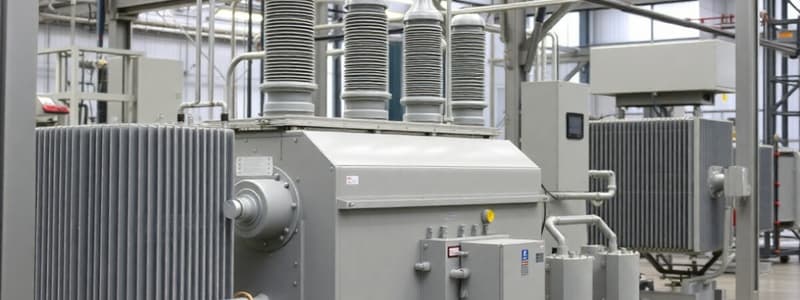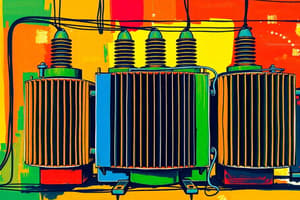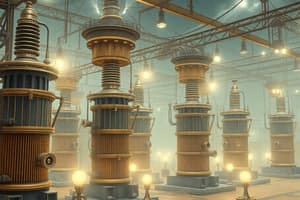Podcast
Questions and Answers
Which of the following components is NOT part of a simple large-scale power system?
Which of the following components is NOT part of a simple large-scale power system?
- Generation source
- Transmission system
- Load or demand
- Advanced monitoring equipment (correct)
What is the primary function of a transformer sub-station in a power system?
What is the primary function of a transformer sub-station in a power system?
- To distribute power directly to households
- To increase voltage for long-distance transmission
- To generate power at a high voltage
- To reduce high voltages from transmission lines to intermediate voltages (correct)
How is power primarily defined in an electrical context?
How is power primarily defined in an electrical context?
- The instantaneous rate of consumption of energy (correct)
- The voltage level at which electricity is transmitted
- The ability to store energy for future use
- The total energy consumed over time
What unit is used to measure energy derived from power over time?
What unit is used to measure energy derived from power over time?
Which factor contributes to complications in the transmission system?
Which factor contributes to complications in the transmission system?
In electrical formulas, how is power calculated for direct current (dc)?
In electrical formulas, how is power calculated for direct current (dc)?
What is a significant limitation of a simple power system?
What is a significant limitation of a simple power system?
What is the main purpose of transformers in power systems?
What is the main purpose of transformers in power systems?
What is one reason why high voltages are used in transmission lines?
What is one reason why high voltages are used in transmission lines?
Which voltage levels are typically output from transformer sub-stations for local distribution?
Which voltage levels are typically output from transformer sub-stations for local distribution?
What are the cooling mechanisms commonly used in transformers?
What are the cooling mechanisms commonly used in transformers?
What is the primary function of circuit breakers in a power system?
What is the primary function of circuit breakers in a power system?
What is the consequence of having low resistance in busses with large cross-sections?
What is the consequence of having low resistance in busses with large cross-sections?
What is the purpose of capacitor banks in power systems?
What is the purpose of capacitor banks in power systems?
Why must transmission lines be kept away from the ground?
Why must transmission lines be kept away from the ground?
What was one of the primary functions of the transformer invented in 1885?
What was one of the primary functions of the transformer invented in 1885?
What happens when current is reduced in a transmission line at high voltage?
What happens when current is reduced in a transmission line at high voltage?
Which power generation method was first demonstrated by Tesla in the late 1880s?
Which power generation method was first demonstrated by Tesla in the late 1880s?
What was a major outcome of the Public Utilities Regulatory Policies Act (PURPA) enacted in 1978?
What was a major outcome of the Public Utilities Regulatory Policies Act (PURPA) enacted in 1978?
Why were electric utilities regarded as 'natural monopolies' in the early 1900s?
Why were electric utilities regarded as 'natural monopolies' in the early 1900s?
What did the National Energy Policy Act of 1992 aim to achieve in the electricity market?
What did the National Energy Policy Act of 1992 aim to achieve in the electricity market?
What was a significant technological advancement for electricity transmission that occurred in 1893?
What was a significant technological advancement for electricity transmission that occurred in 1893?
Which of the following is NOT a component of power generation systems?
Which of the following is NOT a component of power generation systems?
What was a key challenge faced by the electricity sector in the 1970s?
What was a key challenge faced by the electricity sector in the 1970s?
Flashcards are hidden until you start studying
Study Notes
Turbines
- Difficult to replace
- Often have a spare kept on hand
Busses
- Uninsulated electrical conductors
- Large cross-section allows for low resistance
- Must be kept far from the ground and other components to avoid arcing
Switches & Switchyards
- Used to redirect electrical power
Transformers
- Change the voltage of electricity
- Increasing voltage is called “stepping up”
- Decreasing voltage is called “stepping down”
- Often run hot and need to be cooled
- Prone to exploding, due to the oil inside
- Utilize cooling fins, fans, and blast walls
Circuit Breakers
- Stop the flow of current if too much flows, preventing a short circuit or excess demand
Capacitor Banks
- Smooth out spikes or “glitches” in the voltage of electrical lines
Transmission Lines & the “Grid”
- High voltages reduce the energy wasted as heat in the wires, which reduces the power loss
- Transformers cannot add energy, so increasing voltage reduces current, which reduces power loss
Transformer Substations
- Reduce high transmission line voltages ( >100 kV ) to intermediate voltages needed for towns or sections of cities ( typically 66 kV or 33 kV)
Smaller Power Transformers
- Reduce voltage further to the 240 V delivered to homes
Components of a Power System
- Generation - Source of power, ideally with a specified voltage and frequency
- Load - Consumes power, ideally with a constant resistive value
- Transmission System - Transmits power, ideally as a perfect conductor
- Distribution System - Local reticulation of power
- Control equipment - Coordinates supply with load
Complications
- No ideal voltage sources exist
- Loads are seldom constant and are rarely only resistive
- Transmission systems encounter resistance, inductance, capacitance, and flow limitations
- Simple systems lack redundancy, meaning a failure in a single component can cause the entire system to fail
Power
- The instantaneous rate of consumption of energy, or how hard something is working
- Power = Voltage x Current (DC)
- Power Units:
- Watts (W)
- Kilowatts (kW)
- Megawatts (MW)
- Gigawatts (GW)
- U.S. installed generation capacity is around 1,000 GW
- Maximum load in Austin is around 2,500 MW
- Maximum load for UT campus is around 50 MW
Energy
- The integration of power over time, or how much work is accomplished over time
- Units used:
- Joule (J)
- Kilowatthour (kWh)
- British Thermal Unit (Btu)
Brief History of Electric Power
- Early 1880s - Edison introduced the Pearl Street DC system in Manhattan
- 1884 - Sprague produced a practical DC motor
- 1885 - The transformer was invented
- Mid 1880s - Westinghouse/Tesla introduced the AC system
- Late 1880s - Tesla invented the AC induction motor
- 1893 - The first 3-phase transmission line operated at 2.3 kV
- 1896 - AC lines delivered electricity from hydroelectric generation at Niagara Falls to Buffalo
- Early 1900s - Private utilities supplied all customers in an area, considered a “natural monopoly”
History, cont’d
- By the 1920s - Large interstate holding companies controlled most electricity systems
- 1935 - Congress passed the Public Utility Holding Company Act
- 1935/6 - The Rural Electrification Act brought electricity to rural areas
- 1930s - Electric utilities were established as vertical monopolies
- 1970s - Inflation, stagnation of demand growth, rising fossil fuel prices, calls for conservation, and growing environmental concerns led to increased prices and calls for industry changes
- 1978 - The Public Utilities Regulatory Policies Act (PURPA) was passed, mandating utilities to purchase power from independent generators
- 1992 - The National Energy Policy Act opened the industry to competition, mandating “nondiscriminatory” access to the high voltage transmission, attempting to create true competition in generation
History, cont’d – 1990’s & 2000’s
- 1996 and 1999 - Texas followed suit with similar legislation
Studying That Suits You
Use AI to generate personalized quizzes and flashcards to suit your learning preferences.





